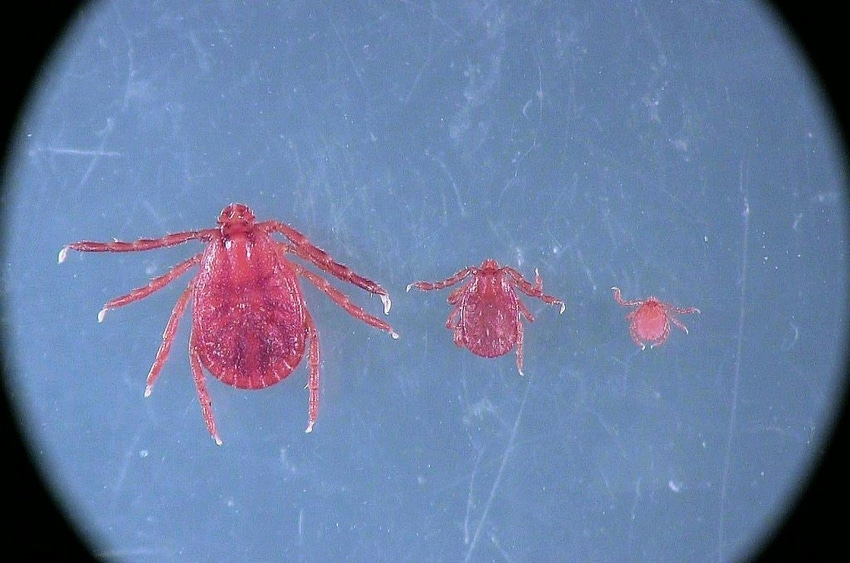Invasive Asian longhorned ticks can extract enough blood to cause anemia in grown livestock and death in young animals.
November 19, 2019

Invasive Asian longhorned ticks (Haemaphysalis longicornis), a foreign parasite that can transmit a variety of blood-borne pathogens, are spreading rapidly in the U.S., and while they have yet to test positive for pathogens, their increasing prevalence threatens American farmers, livestock, companion animals and wildlife, according to an announcement from the Foundation for Food & Agricultural Research (FFAR).
In response to this threat, FFAR awarded a $150,000 Rapid Outcomes from Agriculture Research (ROAR) grant to the University of Tennessee Institute of Agriculture (UTIA) to map the tick’s spread and develop response strategies to protect farmers, ranchers and their animals.
As the name implies, the Asian longhorned tick is native to China, Japan, Korea and other parts of Asia. The tick arrived in the U.S. in 2017 and was initially found in locations that did not have a clear connection to Asia, FFAR said, noting that experts are not clear on how the tick came to the U.S. As of September 2019, the parasite has been detected in 12 states, from Connecticut to Arkansas.
FFAR explained that the tick multiplies quickly thanks to asexual reproduction and is capable of rapid infestation of fields and host animals. One female can start a population, and to date, no males have been found in the U.S. The ticks feed in large population clusters, overwhelming their victims by extracting enough blood to cause anemia in grown livestock and death in young animals.
“The Asian longhorned tick landed in the U.S. seemingly without explanation and has moved quickly though New England, the mid-Atlantic and now the Southeast. Adding to our concern, not much is known about this parasite,” FFAR executive director Sally Rockey said. “We have a rare opportunity to address this infestation now, before the Asian longhorned tick begins spreading pathogens. This grant is taking the first steps to curb the threat by mapping its spread and arming farmers with mitigation strategies.”
To address this threat, UTIA researchers are collaborating with academic, government and industry stakeholders to develop a tick-surveillance network. Members of this network include Tennessee departments of agriculture and health, the Tennessee Wildlife Resources Agency and the U.S. Department of Agriculture (including the Animal & Plant Health Inspection Service, Agricultural Research Service, Forest Service and Veterinary Services) as well as local animal shelters, producers, livestock markets and extension agents.
FFAR said the researchers are also enhancing awareness, evaluating control methods and identifying predictors associated with the tick's presence. The researchers are developing prevention, detection and response strategies as well as educational materials to help detect and eliminate the Asian longhorned tick. This project is enhancing awareness about this pest and empowering stakeholders to make informed pest management decisions.
“Funding from FFAR, along with technical and resource support from our partners, has helped us detect this invasive tick species in eight Tennessee counties,” said Dr. Rebecca Trout Fryxell, a medical and veterinary entomologist in the UTIA department of entomology and plant pathology and research lead for this project. “We are finding them on both canines and cattle. By working with local producers, we are learning more about the life cycle of this species and specifically when and where it is found on a farm. To address this threat, we have been busy increasing awareness. We are excited to start identifying solutions in the spring, when nymph populations are expected to be most problematic.”
This year-long research effort is funded through FFAR’s ROAR program, which rapidly funds research and outreach in response to emerging or unanticipated threats to the nation’s food supply or agricultural systems. The University of Tennessee contributed $150,000 to this $300,000 effort, matching FFAR’s contribution.
Source: Foundation for Food & Agricultural Research, which is solely responsible for the information provided and is wholly owned by the source. Informa Business Media and all its subsidiaries are not responsible for any of the content contained in this information asset.
You May Also Like


.png?width=300&auto=webp&quality=80&disable=upscale)
